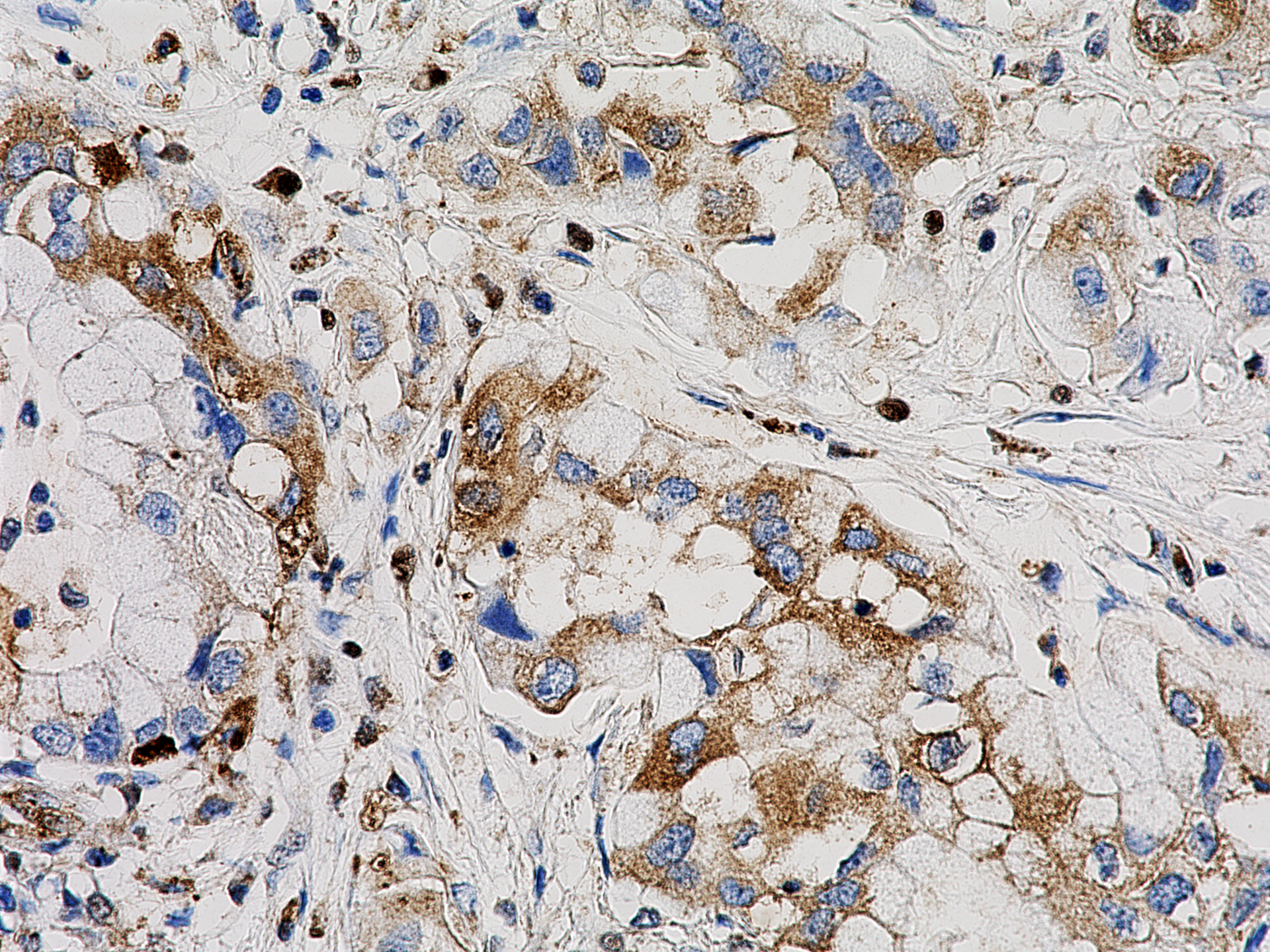PHILADELPHIA – Activating the G protein-coupled estrogen receptor (GPER) – a receptor found on the surface of many normal and cancer tissues – has been shown to stop pancreatic cancer from growing, but may also make tumors more visible to the immune system and thus more susceptible to modern immunotherapy. Researchers at the Perelman School of Medicine at the University of Pennsylvania and Penn’s Abramson Cancer Center observed the effects of GPER activation in human and mouse pancreatic cancer models and published their findings in Cellular and Molecular Gastroenterology and Hepatology today.
For most cancer types, including pancreas, women generally have better outcomes than men. Although the reasons for this are only now emerging, researchers have known for decades that there is a link between the body’s sex hormones and some types of cancer, especially those arising in reproductive tissues such as breast and prostate. However, the idea that cancers in non-reproductive tissues might also be influenced by sex steroid hormones has only recently been considered.
Building on their research showing the anti-cancer activity of GPER in melanoma models, Todd W. Ridky, MD, PhD, an assistant professor of Dermatology at Penn and the study’s senior author, and his lab, examined whether GPER activators may also inhibit other cancer types.
“We know that activating GPER in melanoma models stops the growth of cancer cells and make the tumors themselves more immunogenic, so we wanted to find out what would happen if we selectively activated GPER other tumor types. In this study we examined several pancreatic cancer models and found that synthetic small molecule GPER activators potently inhibited pancreatic cancer cells, and simultaneously rendered the tumor cells more sensitive to other anti-cancer therapies,” Ridky said.
For this study, the Ridky lab worked with the Penn Pancreatic Cancer Research Center (PCRC), directed by study co-author Ben Z. Stanger, MD, PhD, the Hanna Wise Professor in Cancer Research. Using new PCRC mouse pancreatic cancer models, the multidisciplinary team was able to show GPER’s impact on pancreatic cancer growth. In some models, GPER activation inhibited growth and made tumors more sensitive to anti-PD-1 immunotherapy, pointing to the translational potential of improving the efficacy of existing treatments in a cancer type where PD-1 inhibitors have not historically been very effective.
The use of GPER activators is a novel idea in cancer therapy, and has a key difference from most anti-cancer agents. Nearly all current cancer drugs act to block the activity of cellular proteins that are needed by not only the cancer cells, but also by normal cells. As a result, most cancer drugs are associated with major toxicity. In contrast, the estrogenic analog used in the Penn study activates GPER. This approach mirrors something that naturally occurs in the body, as GPER is already present and normally activated by estrogen, especially in females during pregnancy.
“Likely because this is something the human body is already accustomed to, evidence from preclinical animal studies suggested that side effects to this approach would likely be minimal when this moves into the clinic,” said the study’s first author Christopher Natale, Ph.D., Ridky’s former graduate student.
Natale is currently the Vice President of Research at Linnaeus Therapeutics, a company he and Ridky co-founded to further investigate the translational potential of this work. A multi-site Phase I trial in patients with advanced cancer is currently ongoing.
Additional Penn authors on the study include Jinyang Li, Jason R. Pitarresi, Robert J. Norgard, Tzvete Dentchev, Brian C. Capell, and John T. Seykora.
The study was supported by the National Institutes of Health (R01 CA163566, P50CA174523, T32 AR0007465 – 32, F31 CA206325, R41CA228695), the Melanoma Research Foundation, the Dermatology Foundation, and the Penn Skin Biology and Diseases Resource-based Center (P30 – AR069589).
Editor’s Note: Ridky and Natale are scientific co-founders of Linnaeus Therapeutics and hold equity in the company. They are inventors on intellectual property related to this work and may receive additional financial benefits in the future. Penn is also an investor in the company, holds equity interests, and has licensed intellectual property to the company related to this work.
###
Penn Medicine is one of the world’s leading academic medical centers, dedicated to the related missions of medical education, biomedical research, and excellence in patient care. Penn Medicine consists of the Raymond and Ruth Perelman School of Medicine at the University of Pennsylvania (founded in 1765 as the nation’s first medical school) and the University of Pennsylvania Health System, which together form a $7.8 billion enterprise.
The Perelman School of Medicine has been ranked among the top medical schools in the United States for more than 20 years, according to U.S. News & World Report’s survey of research-oriented medical schools. The School is consistently among the nation’s top recipients of funding from the National Institutes of Health, with $425 million awarded in the 2018 fiscal year.
The University of Pennsylvania Health System’s patient care facilities include: the Hospital of the University of Pennsylvania and Penn Presbyterian Medical Center—which are recognized as one of the nation’s top “Honor Roll” hospitals by U.S. News & World Report—Chester County Hospital; Lancaster General Health; Penn Medicine Princeton Health; and Pennsylvania Hospital, the nation’s first hospital, founded in 1751. Additional facilities and enterprises include Good Shepherd Penn Partners, Penn Home Care and Hospice Services, Lancaster Behavioral Health Hospital, and Princeton House Behavioral Health, among others.
Penn Medicine is powered by a talented and dedicated workforce of more than 40,000 people. The organization also has alliances with top community health systems across both Southeastern Pennsylvania and Southern New Jersey, creating more options for patients no matter where they live.
Penn Medicine is committed to improving lives and health through a variety of community-based programs and activities. In fiscal year 2018, Penn Medicine provided more than $525 million to benefit our community.
Original post https://alertarticles.info
